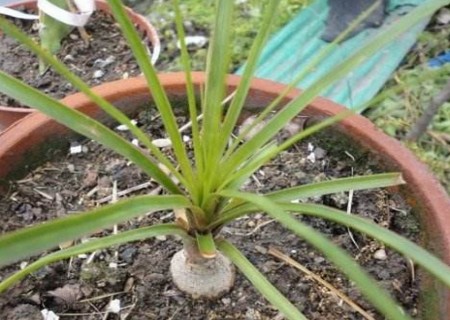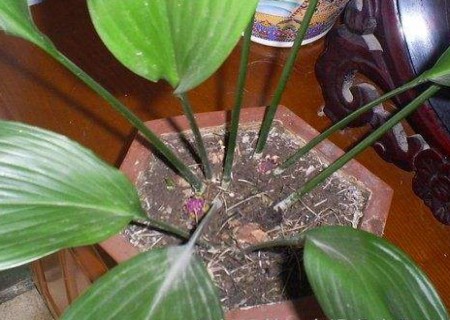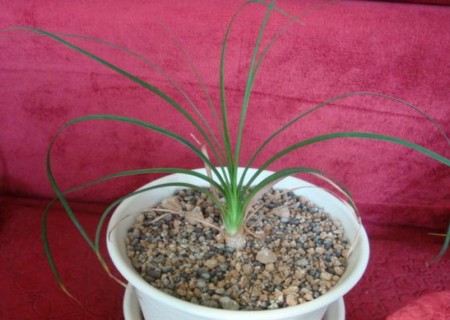Cutting method of wine bottle orchid
Wine bottle orchid, as a flower with ornamental stems and leaves, uses it to decorate the living room, study room, hotel and venue, all of which give people a novel and chic feeling. It can be planted in a variety of specifications as interior decoration: small plants are planted in exquisite pots and placed on the desk and table, showing elegance and elegance; medium and large potted plants are used to decorate halls, conference rooms, reception rooms, hotels, shopping malls and other places, which are very tropical and enjoyable.
In the propagation of bottle orchid, many flower friends like to propagate by cutting, and the bottle orchid sometimes sprouts lateral branches, which can be propagated by cutting, but unlike other tequila plants, there are many sucking buds in the root neck, but only a few lateral branches.

1. Cutting substrate
The pot cultivation of wine bottle orchid can use 2 parts of rotten leaf soil, 1 part of garden soil and 1 part of river sand and a small amount of plant ash as substrate. Family cutting is limited to the conditions, it is difficult to get the ideal cutting substrate, sea sand and saline-alkali areas of river sand should not be used, they are not suitable for the growth of wine bottle orchid.
2. Cutting time
Wine bottle orchid cuttings often use the same year's branches for tender wood cutting in late spring and early autumn, or old branches with last year's branches in early spring.
3. Cuttings selection
When the wine bottle orchid hardwood cuttings were carried out, after the temperature rebounded in early spring, last year's robust branches were selected as cuttings. After cutting off the orchid branches of the wine bottle, select the sturdy parts and cut them into sections 5 to 15 centimeters long, each with more than 3 leaf nodes. Each cuttage usually retains 3-4 nodes, and the cutting method is the same as that of softwood cuttings.
When cutting cuttings, it should be noted that the upper cut is cut flat at about 1 cm above the uppermost leaf node, and the lower cut is about 0.5 cm below the lowest leaf node. the upper and lower cut should be flat and sharp.
4. Cutting skills
After cutting with side branches, it is quite slow to form a bottle-shaped trunk, and the wine bottle orchid with incorrect stem shape can be cut off, buried and propagated to make it grow into a new plant. At the same time, attention must be paid to the disinfection of the wound to avoid decay. Cut off the cuttings to dry slightly, insert them in the sand bed to increase the air humidity, and take root in about 15-20 days after insertion.
5. Maintenance and management
1) temperature
The optimum temperature for rooting of cuttings was 20 ℃ ~ 30 ℃, which was lower than 20 ℃, the rooting of cuttings was difficult and slow, when the temperature was higher than 30 ℃, the upper and lower cuttings were easy to be infected and rotted by bacteria, and the higher the temperature, the greater the proportion of rot.
When there is a low temperature after cutting, the heat preservation measure is mainly to wrap the flowerpot or container used for cutting with thin film; when the temperature is too high after cutting, the cooling measure is mainly to shade the cuttings, to cover 50-80% of the sun, and at the same time, spray the cuttings 3-5 times a day, with more times of spraying when the temperature is higher in sunny days, lower temperatures and higher temperatures in rainy days, but less or no spraying times.
2) Lighting
Cutting propagation is inseparable from sunlight, because cuttings continue to carry out photosynthesis to produce nutrients and rooting substances to supply the rooting needs of wine bottle orchid. However, the stronger the light, the higher the temperature in the cuttings, the more exuberant transpiration of cuttings, and the more water consumed, which is not conducive to the survival of cuttings. Therefore, after cutting, the sun must be shaded by 50% to 80%, and then gradually removed after the root system grows: remove the sunscreen at 4:00 every sunny day, and cover it before 9:00 the next day.
3) Fertility and water
Fertilizer and water management should be strengthened in the growing season from March to October to promote stem expansion. Because the inflated stem can store a certain amount of water and has a strong ability to withstand drought, so when watering, we should take the wetness of the basin soil as the degree, grasp the principle that it would rather be dry than wet, and avoid stagnant water in the basin soil, otherwise the fleshy root and stem are easy to rot. Especially when the temperature drops after the end of autumn, the amount of water should be reduced to improve the cold resistance of the tree. Liquid fertilizer or compound fertilizer is applied twice a month during the growing period, and pay attention to increase phosphorus and potassium fertilizer when applying fertilizer.
4) pruning
Wine bottle orchid resistant to barren, resistant to pruning, according to the needs of greening, can be pruned into a variety of patterns, and often trim the old leaves, can promote plant growth and height. When the plant enters the dormant or semi-dormant period in winter, the branches such as thin, disease and insect, withered and overdense should be cut off. The branches can also be arranged in combination with cuttings.
Time: 2019-06-09 Click:
- Prev

How does one-leaf orchid reproduce? Propagation method of one-leaf orchid
The plant division method is mostly used for the reproduction of Cymbidium, and the sandy loam rich in humus should be selected, which is fond of moist soil. In the exuberant stage of growth, thin fertilizer and water are applied to the plant once a week. It grows well in bright places without direct sunlight, likes warmth, and avoids severe cold. The ambient temperature should be kept between 15 and 25 ℃.
- Next

Seed propagation method of bottle orchid
Wine bottle orchid, also known as elephant leg tree, false leaf tree family. Bottle orchid is a foliage plant, evergreen small trees. Native to dry and hot areas of Mexico. Bottle-bottle orchid is a tree-like multi-succulent plant, the plant height of origin up to 10 meters, pot planting generally 0.5-1.0 meters high. Due to the peculiar shape of the stem, the base is particularly dilated
Related
- Fuxing push coffee new agricultural production and marketing class: lack of small-scale processing plants
- Jujube rice field leisure farm deep ploughing Yilan for five years to create a space for organic food and play
- Nongyu Farm-A trial of organic papaya for brave women with advanced technology
- Four points for attention in the prevention and control of diseases and insect pests of edible fungi
- How to add nutrient solution to Edible Fungi
- Is there any good way to control edible fungus mites?
- Open Inoculation Technology of Edible Fungi
- Is there any clever way to use fertilizer for edible fungus in winter?
- What agents are used to kill the pathogens of edible fungi in the mushroom shed?
- Rapid drying of Edible Fungi

